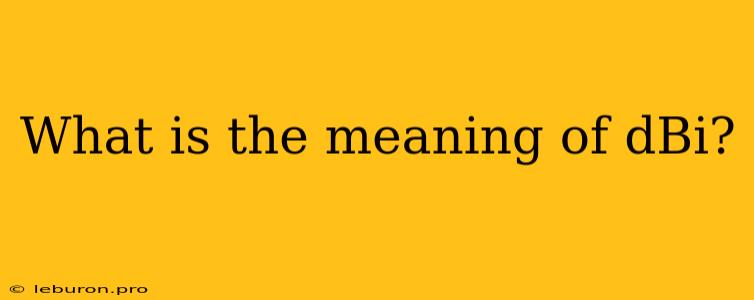The term "dBi" is frequently encountered in the realm of wireless communication, particularly when discussing antenna performance. It stands for "decibels relative to an isotropic radiator," and its significance lies in quantifying an antenna's ability to concentrate radio waves in a specific direction. This article delves into the meaning of dBi, exploring its fundamental principles and practical applications.
Understanding the Basics: Isotropic Radiators and dB
At the heart of dBi lies the concept of an isotropic radiator. Imagine a theoretical antenna that radiates radio waves equally in all directions, forming a perfect sphere of signal. This hypothetical antenna is the benchmark against which all real-world antennas are measured. The dBi unit expresses an antenna's gain relative to this idealized isotropic radiator.
The "dB" part of dBi signifies decibels, a logarithmic unit commonly used in signal strength measurements. Decibels provide a convenient way to represent large variations in power or signal levels on a more manageable scale.
Deciphering dBi: Gain and Directivity
Gain refers to an antenna's ability to amplify the signal strength in a specific direction. It quantifies how much stronger the signal is in that direction compared to an isotropic radiator. A higher dBi value indicates a more focused beam and stronger signal in that direction.
Directivity, on the other hand, is a measure of an antenna's ability to concentrate its radiated power in a specific direction. It represents the ratio of the power density in the direction of maximum radiation to the average power density over all directions.
While both gain and directivity are related to an antenna's directionality, there is a subtle difference. Gain takes into account the antenna's efficiency, whereas directivity only considers the shape of the radiation pattern.
Real-World Applications of dBi
The dBi rating of an antenna is crucial for various wireless applications:
1. Long-Range Wireless Communication
For applications demanding long-range signal transmission, such as cellular base stations, satellite communication, or point-to-point microwave links, antennas with high dBi values are essential. These antennas focus the signal into a narrow beam, minimizing signal loss and maximizing coverage over longer distances.
2. Wireless LANs and Wi-Fi
In indoor wireless networks like Wi-Fi, the choice of antenna can significantly impact network performance. Antennas with higher dBi values can provide stronger signal coverage in specific areas, improving signal strength and reducing dead zones.
3. GPS Receivers
Global Positioning System (GPS) receivers utilize antennas with specific dBi ratings to receive satellite signals. Antennas with higher dBi values can improve signal reception, even in challenging environments with weak satellite signals.
4. Satellite Television
Satellite TV systems employ antennas with high dBi values to receive signals from orbiting satellites. These antennas are designed to focus the signal from a specific satellite, ensuring clear reception despite the long distances involved.
Factors Influencing dBi
Several factors can influence the dBi rating of an antenna:
-
Antenna Design: The physical shape, size, and material of an antenna significantly impact its dBi value. Directional antennas, such as parabolic dishes, typically have higher dBi ratings than omnidirectional antennas.
-
Frequency: The operating frequency of an antenna can affect its gain and directivity. Higher frequencies generally allow for narrower beamwidths and higher dBi values.
-
Polarization: The orientation of the electromagnetic field in a radio wave, known as polarization, can influence the dBi value. Antennas with vertical polarization, for instance, may have different dBi ratings compared to antennas with horizontal polarization.
Conclusion
The dBi value provides a crucial metric for assessing an antenna's ability to focus radio waves in a specific direction. This metric plays a vital role in wireless communication systems, influencing signal strength, coverage, and overall performance. Understanding the meaning of dBi allows professionals in the field to select the appropriate antennas for various applications, optimizing wireless communication systems and ensuring reliable signal transmission.
